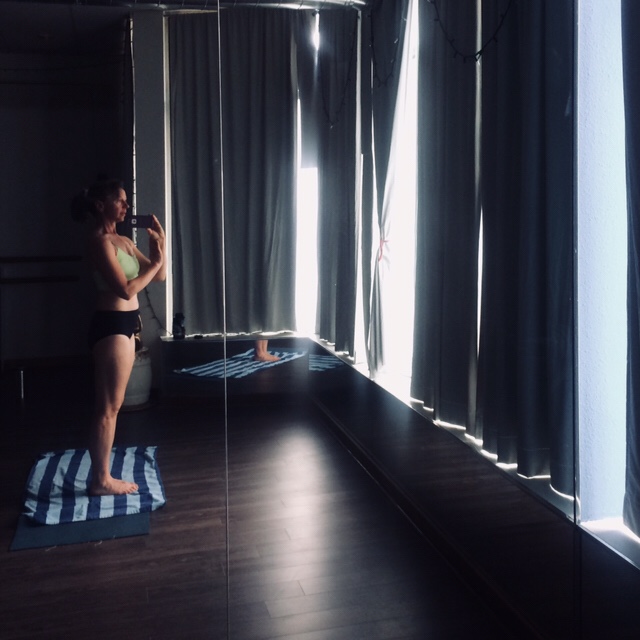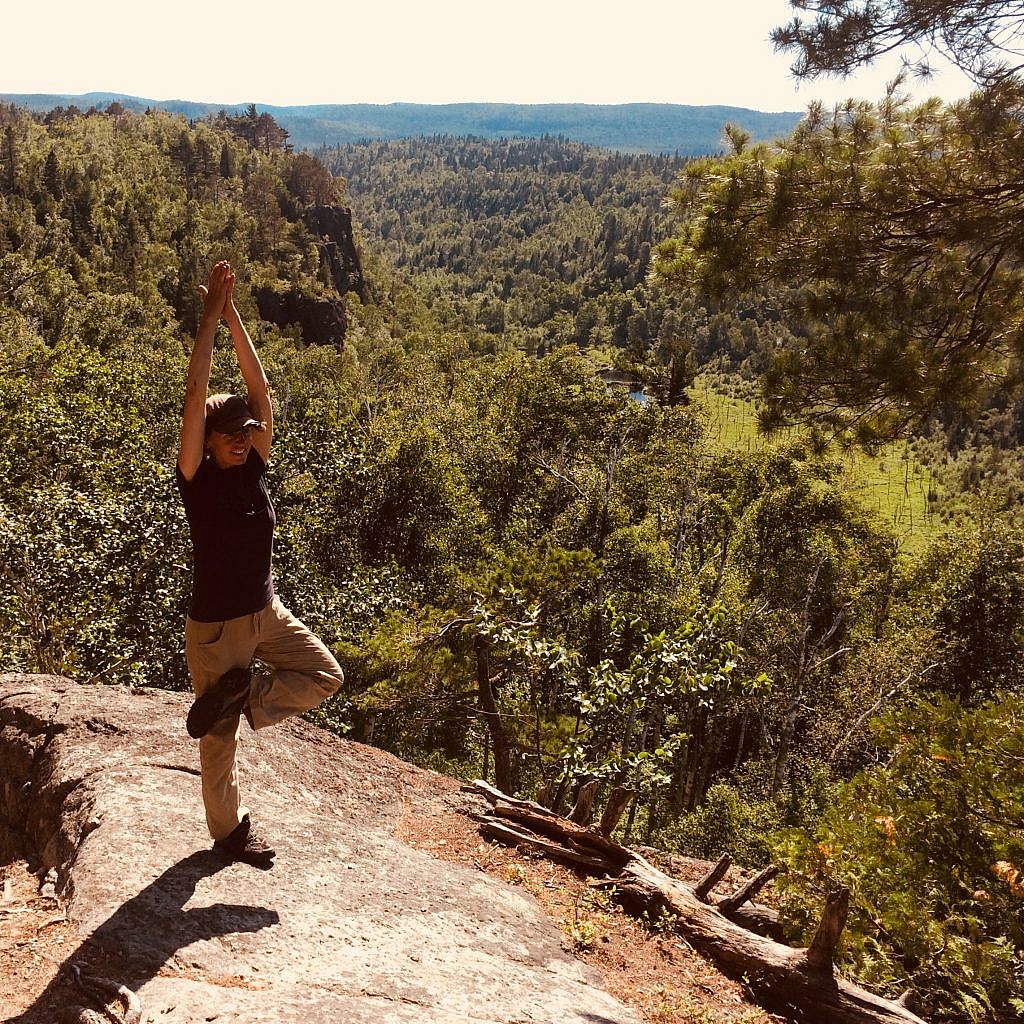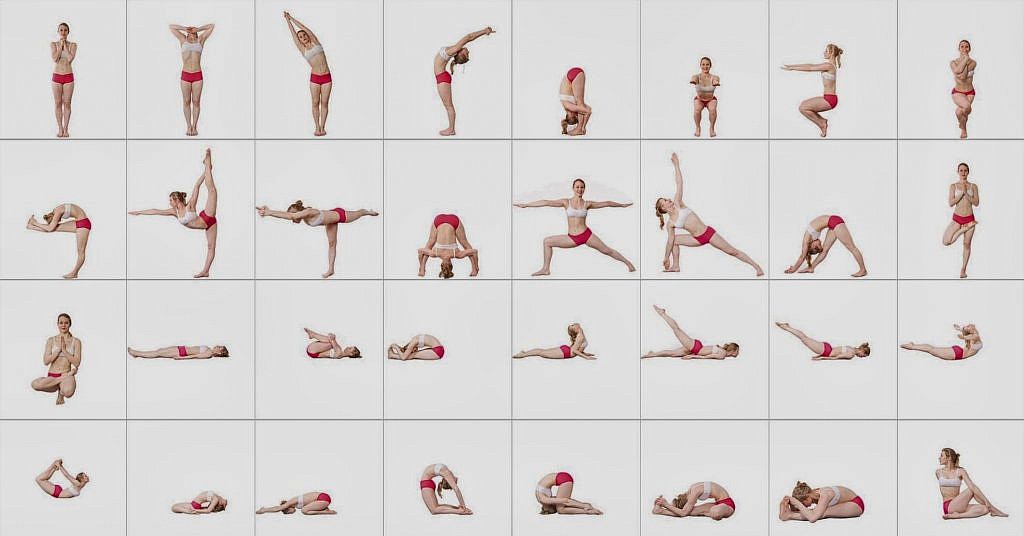The very heart of yoga practice is ‘abyhasa’ – steady effort in the direction you want to go.
Sally Kempton

As I prepare for the Continental Divide Trail with brand new titanium hips, I am revisiting this post on the benefits of yoga and hot yoga in particular. I don’t do the full poses – or even get close! – but I have been assured my teachers that even doing the part of the pose is incredibly beneficial. You can also listen to this week’s Blissful Hiker podcast for more about what I do to get in shape for a 4 1/2 month thru-hike. ~Blissful
A little over a year ago, I started practicing traditional Bikram Hot Yoga. Yes, he doesn’t have quite the reputation you’d want to follow these days with bankruptcies, lawsuits and sexual misconduct, but his strenuous and intense series of twenty-six hatha yoga poses has been one of the most effective workouts for me, proving both energizing and therapeutic.
Does yoga cure all ailments? Probably not, but I feel so good that I believe yoga is a crucial addition to my life as a long distance backpacker.
Here are ten reasons why you should add Hot Yoga to your thru-hike prep.
1. You will learn to manage heat.
Granted, hypothermia is a real danger in any outdoor activity, particularly when you backpack and are fully responsible for your shelter. But hyper-thermia can also be a significant risk, especially if hiking in the desert, beach or other shade-less region. Hot Yoga is typically practiced in conditions far more intense than any you’d encounter on a hike with the room set around 105-108 degrees Fahrenheit with high humidity. Just entering that heat can make you feel overwhelmed, like something is pressing on your lungs.
To survive a 90-minute class – and a thru-hike – you’ll want to consider loose-fitting clothing to let the sweat flow. You should also drink a lot of water, not in gulps, but in many mini-sips, and, perhaps most importantly, come to class already well hydrated. The yoga poses are difficult and teach you to push hard while still keeping the heart rate – and breath – under control.
2. You will discover how to stay focused when feeling unfocused.
Hot Yoga is a tough program that claims to work every muscle, bone, joint, ligament, tendon, gland and organ in the body. I wouldn’t necessarily say that the halfmoon pose, for example, is particularly difficult, but trying to bring the mind to holding it correctly with the arms straight at the ears, knees locked and the body in one line while the torso gently folds over your hips requires attention to detail.
With the encouragement of a superb teacher, you are continually asked to bring the mind to each aspect of the pose from wherever you are that day. A long hike over many days can also catch us in a variety of moods and levels of commitment. If we learn to stay focused on one step at a time, we can string together all the steps to walk a trail.
Which brings me to my next point…
3. You will learn how to see something through.
Hot Yoga is designed to keep you from pushing beyond what you are capable of doing, because it’s so hot. At the very least, you’ll need to leave the room to cool off or simply sit down to catch your breath. At the worst, you might pass out from being overheated, though more likely you’ll simply back off. What you begin to find in your practice is the tools to see it through.
A friend of mine just hiked 100 miles of the Colorado Trail. She says on the first days, she hadn’t quite figured out her rhythm. It was very hot and exposed and she arrived at her campsite completely wrecked and uncertain she’d finish the hike. So she adjusted her speed, and her expectations. It wasn’t so much that she completely rerouted or changed her itinerary, but rather that she tuned into her body in a different way, much like is required in every yoga practice to see it through the full 90 minutes.
4. You will improve your balance.
Classic hot yoga runs through a series of twenty-six poses that include demanding balance ones like eagle, standing head-to-knee, standing bow, and balancing stick. Each one is built on a premise of locked knees with the hips in line. To do them well, and to hold them for a full minute, you must bring each side of your body into balance while not overcorrecting or over-muscling. Yes, concentration plays a role, but so does discovering the body working optimally.
This translates directly into thru-hiking when walking a ridge, crossing a river, or traveling down a steep slope. Injuries usually happen when we roll our ankles or lose control and fall. A yogi who can hold what is aptly named awkward pose – sitting back in an invisible chair with the thighs at right angles and the feet on tiptoes while the arms are locked out straight in front of them – will have an edge on any stumbly parts of the trail.
5. You will also improve your core strength.
All of that balancing works the legs, but also tightens the core. For sure, you will be a buff hiker, but what really prepares you for the stress of thru-hiking is the floor series. These are all inversions from a prone position on your stomach. They are evil, sadistically working muscles you never knew you had, especially in your back. You will hold for what seems an eternity four poses, and then, repeat them. Each increases in difficulty too; cobra, locust, full locust, and bow pose.
And if that’s not enough of a work out, between each subsequent floor pose is a full sit-up from the corpse pose. Why is core strength so important to hiking? You are using the strongest part of your body to stay upright and move. Even if you’re an ultra-light backpacker, you carry some weight on your back and you don’t want to stress the legs compensating for a weak core.
Read next – training is life, life training

6. You will stretch and loosen tight muscles.
About how far into a hike are you unable to squat anymore? For me, it’s usually day two when I go off to pee and find I need to hold onto something – or someone – for balance or I’ll topple over. Why? Because my quads have tightened up to the point they won’t bend properly. Fixed firm and half tortoise poses begin with the yogi sitting on her heels stretching the quads in half. As you focus on the upper body requirements of these poses, the quads eventually let go of their tension and allow the body to move more deeply.
Hiking is repetitive in its motion and is bound to tighten up parts of your body. The looser you go into the activity, the more likely your body will remember what it feels like to work at its most supple and you will also have tools to loosen things up on the go.
7. You will get the juice flowing to your joints.
After the standing series, hot yogis lay down on the floor in the aptly named corpse pose for two minutes before a very relaxing pose called wind removing. It is very simple to do as you pull your bent knee towards your armpit. It’s done on each side and then all at once, as you attempt to lay the spine out on the floor. I am nowhere near getting mine down, but it’s fun trying.
Wind removing can be done in your tent to massage the muscles and your insides as well. It’s said that it’s good for the gut and digestion. Tree and triangle open the hips and spinal twists have the sensation of squeezing out the bad juju. Hikers can begin to look hunched and gnarled into themselves if they don’t twist the spine and open the hips. I am convinced that yoga has slowed down my arthritis by bringing heat and blood into the joints.
8. You will learn how to be still and notice.
Lately I’ve been annoyed that people are bringing their music to the trails. If you want to be in the outdoors with headphones jammed into your ears, by all means, do it, but please don’t bring speakers that force everyone to listen to music while we’re enjoying the simple pleasure of the wind in the trees and the birds singing or maybe just the silence of nature.
I’m also, by nature, not a record-seeker and prefer to enjoy the beauty of where I am to the speed at which I can get through it. If either of these describes you, you might want to consider the slow pace of hot yoga. You won’t have a phone to look at in class and talking is discouraged.
There’s something of a cloister in yoga that begins to relax the mind to the point that you notice things in a far gentler way. Thru-hiking takes time and is not always blissful, but when you slow down and focus on your breath or the movement of your feet or hips or the swing of your arms, it can take on a more mindful atmosphere.
9. You will begin to breathe with the world.
Classic hot yoga begins with parayma breathing, a super long deep breathing exercise done while standing. Your hands begin under your chin and fan out like wings as you breathe in and then move forward, elbows touching as you breathe out. It tires you all over even as it energizes, your feet and legs locked into place and touching, your shoulders holding your arms as they move in slow motion, your lungs trying to control the timing of your breath, far harder to do on the inhale than exhale.
After ten repetitions, then another ten, you suddenly discover your motions are in unison with everyone else around you, like you’re one giant organism. As a thru-hiker, you want to be connected to your own breathing up steep climbs and after long arduous days, but you also want to find a kind of sympathetic rhythm with those you meet. We all need to learn to “hike our own hike,” but that being said, we also share the trail and want to bring our best selves to it.
10. You will find that yoga is a practice the way a thru-hike is a kind of practice.
Hot Yoga is a practice. I love that word. It’s not a workout, not an event, not something to just tick off your “to-do” list. It’s far more integrated into wherever you are in the moment. When you start a thru-hike, the end is very far off indeed. To think of finishing – even of planning every day – can be overwhelming. You don’t know how your days will go, whether you’ll move faster or slower, how the weather will affect you, if you’ll need a rest or want to move on.
In yoga, you learn to not so much seize the day as let the day unfold. This non-judgmental attitude creates room for surprise and allows you to say yes to what is, rather than pre-determine what success means.
Namaste.
Listen next – Blissful Hiker podcast #53: CDT prep: getting in shape



One Response